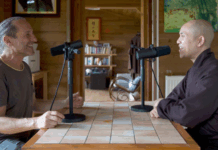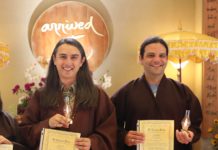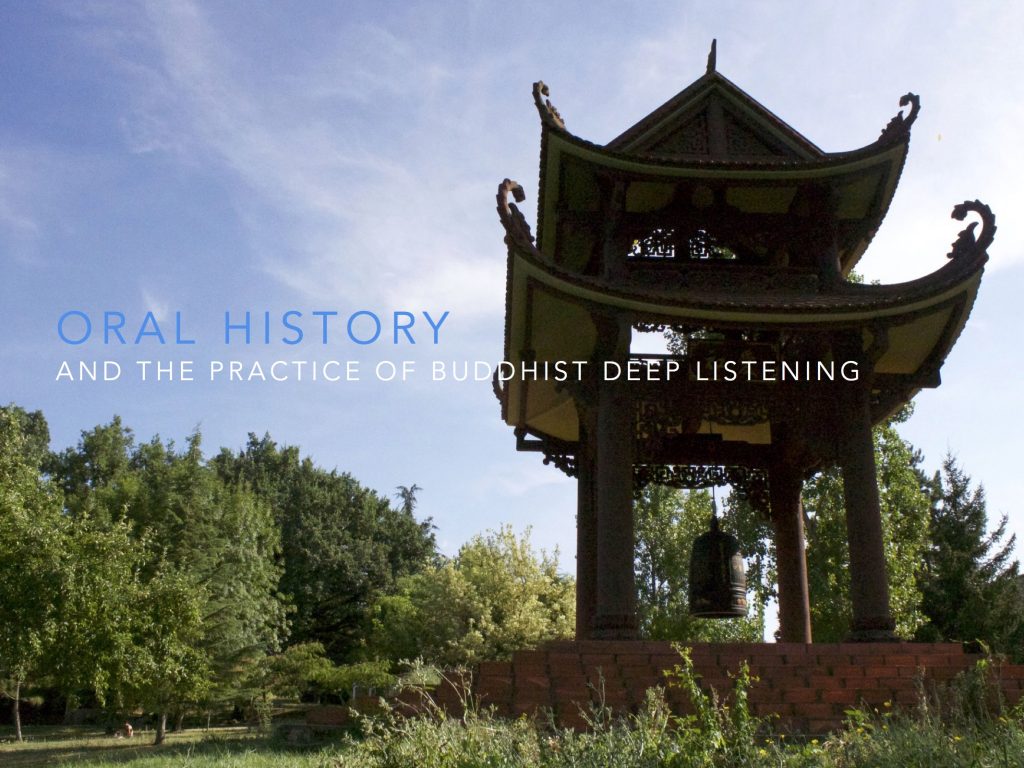Wake Up has this energy of effortlessness, aimlessness, just the joy of being together. The joy of sitting and the joy of sharing life.
I have a lot of trust in the Sangha. Because everyone is so different, they bring so much to the reunion of the togetherness. Our unity is much stronger than individual thinking or pursuit.
Every Friday when I get home or I have a lot of work, it’s not a burden for me to go to Wake Up. It will help me to get more energy and be okay with everything.
And I feel so happy that people come to share, and feel that energy of openness and support. Because, for me, that is Wake Up.
– Aurora Leon, Founding Member of Wake Up New York
I have arrived. I am home.
In the fall of 2011, a group of young monastics and lay friends gathered on the East Coast of the United States to visit ten local universities and practice mindfulness with the students. Over the course of three weeks, the group wound its way through New England and the Mid-Atlantic region, concluding the journey at Columbia University in New York City. Mindfulness had begun to enter into popular culture and new Sanghas arose along the tour route, fueled by the energy of established practitioners and excitement of beginner’s mind.
In a recent interview, Brandon Rennels, formerly a Wake Up Coordinator at Blue Cliff Monastery, recalled those final days of the tour, “I remember leaving the Gershwin [Hotel] and walking through the streets of the city—having the feeling of what it’s like to bring one’s practice out. That was one of the first times I’d done walking meditation with Sangha. We also had a concert that evening: a music and mindfulness event with Joe Reilly, who is a singer and songwriter in the Plum Village tradition. That kind of multifaceted element [occurring during a Day of Mindfulness] helps one to remember that practice and life happen in each moment. Some of those moments are set in a formal meditation setting. And a lot are spent outside of that.”
This, too, was my personal entry point into Wake Up. After being loaned a copy of Thích Nhất Hạnh’s book Peace is Every Step earlier that summer, I learned that Thầy was going to be speaking in New York City during the 2011 North American tour. A few weeks later, I found myself back in Manhattan as the Wake Up delegation rolled through. I was a student in my last year of university and resided about three hours upstate. My aspirations to live in New York were then in their early stages.
I remember navigating the subway by directions neatly written in my notebook—still resisting the constant connectivity of a smartphone at that time. And I recall arriving early at the Gershwin (now the Evelyn Hotel), with lamps like horns or raindrops adorning the entrance. I sat for a moment upon a ledge down the street as I surveyed the crowd, awaiting an influx of young people.
In the doorway to the backroom where the Day of Mindfulness was held, we were handed a booklet. On the first page it read, “Being mindful is simple, but not always easy. The practices we’ll cover will equip you with your own ‘mindfulness toolkit’ that you can use anywhere, anytime, with anybody. Practicing mindful breathing, sitting, walking, eating, talking, and listening… all these can open doors of happiness and peace. They provide some space between you and the stress found in the realities of everyday life. With this space comes joy, relief, and healing; you are free to just be.”
“Mindful listening.” It was a term that became embedded within me as the semester wore on, unveiling the career path that has nourished me these past three years. Known also as “deep listening,” Thầy has defined the practice as, “The kind of listening that can help relieve the suffering of another person. You can call it ‘compassionate listening.’ You listen with only one purpose: to help him or her to empty his heart. Even if he says things that are full of wrong perceptions, full of bitterness, you are still capable of continuing to listen with compassion. Because you know that listening like that, you give that person a chance to suffer less.”
https://www.youtube.com/watch?v=EjyF1ARV5AM
Mindful, deep, compassionate listening is a core component of the Five Mindfulness Trainings, the fourth of which focuses on the commitment to actively cultivate the practice “in order to relieve suffering and to promote reconciliation and peace in myself and among other people, ethnic and religious groups, and nations.” However, it was not until recently that I realized how compassion is such a dynamic act and how far its impact can echo.
Delving further into the matter, Thích Nhất Hạnh offers the following definitions:
empathy, n.: the experience of feeling another person’s joy or suffering as one’s own
altruism, n.: an unselfish interest in the welfare of other people
compassion, n.: the intention and capacity to relieve and transform suffering and lighten sorrow (Teachings on Love, p. 6)
Thầy says that compassion, like the lotus flower, is made up of non-compassion elements. Suffering is intertwined with happiness—all feelings, like people, “inter-are.” We live in a reality of co-existence and interconnection. Without experiencing suffering, one cannot fully empathize with the feelings of another. Without looking deeply inward, it is difficult to generate altruism outward. Without transforming one’s own suffering, it is challenging to offer true compassion towards other people.
Addressing whether compassion is a sign of weakness or reserved for those who are emotionally inclined, Thầy urges, “Compassion can be very powerful. If one is compassionate, one can be very active. And one can sacrifice his life for the well being of other people… [The Lotus Sutra states that] the nature of compassion is like the thunder. And the nature of loving-kindness is like the great cloud… sheltering and offering freshness and light.”
It takes conscious effort to attune oneself in this way: to openly embrace all beings and seek to alleviate their suffering like the bodhisattva Avalokiteśvara. Through this lens, compassion is considered an undertaking of great strength and fortitude. And deep listening—through which the listener aspires to aid the person speaking by providing their full attention and understanding—can be viewed as both a compassionate and courageous practice.
These teachings have led me to pursue one possible manifestation of this call to action. One year after glimpsing the vibrancy of Wake Up through the Northeast Tour, I moved to New York City to pursue a graduate degree in the field of oral history. A fateful encounter with residents at Morning Sun Mindfulness Practice Center (which I wrote more about for this Wake Up website here) set me on a path along which the notion of Right Livelihood has become the guiding light. I now serve as an administrator to the Oral History program at Columbia University and have been recording the stories of practitioners in the Plum Village tradition ever since.
To provide some further clarity: Oral history is the practice of interviewing people and recording their life stories about the intersection of personal, historical, and cultural elements. An oral historian may be curious about the impact of a particular event on a group of people. Or they may be interested in how a community’s memory of an experience differs from the media’s reporting of it. But most notably, the oral history interview is a safe space in which anyone may be listened to intently and embraced with respect. In that sense, it is much like Dharma Sharing.
***
With that background formally shared, this is where YOU come in!
This summer, mindfulness and oral history will join forces in the form of the WAKE UP ORAL HISTORY PROJECT. Through the kind support of Brandon Rennels (formerly at Blue Cliff Monastery), Thầy Pháp Lưu (Plum Village), Nick Neild (Wake Up San Diego), the Caretaking Council of Wake Up New York, and the Columbia Center for Oral History Research, I will be traveling through Europe and North America to teach workshops and conduct audio interviews with a number of Wake Up Sanghas. We will be sharing stories of community and practice, and tracing the development of the Wake Up movement.
There will be an article published here next week further explaining the project’s goals and intentions. In the meantime, please feel free to review this document for a thorough summary.
To receive more information about this initiative and learn how you or your Sangha can become involved, please send a message to oralhistory@wkup.org. To follow the project in the coming weeks, like the Wake Up Oral History Project Facebook page, where a number of photographs and interview excerpts will soon be posted. I am currently intending to visit Plum Village, Freiburg, München, Arnhem, London, Dublin, New York, and San Diego. If you are in the area and would like to meet up, please do get in touch!
Looking forward to enjoying your company and listening deeply to the stories of the global Wake Up Sangha.
Erica Fugger, Wake Up New York
Compassionate Healer of the Heart
Erica Fugger (USA) is a member of Wake Up New York and the Riverside Sangha of Manhattan. Four years ago, she was loaned a copy of Peace Is Every Step, and has been on the path of practice ever since. Erica enjoys meditating in the parks of New York City and trekking home to hike the hills of Connecticut. She has been conducting oral history interviews with practitioners in the Plum Village tradition since 2012.



















